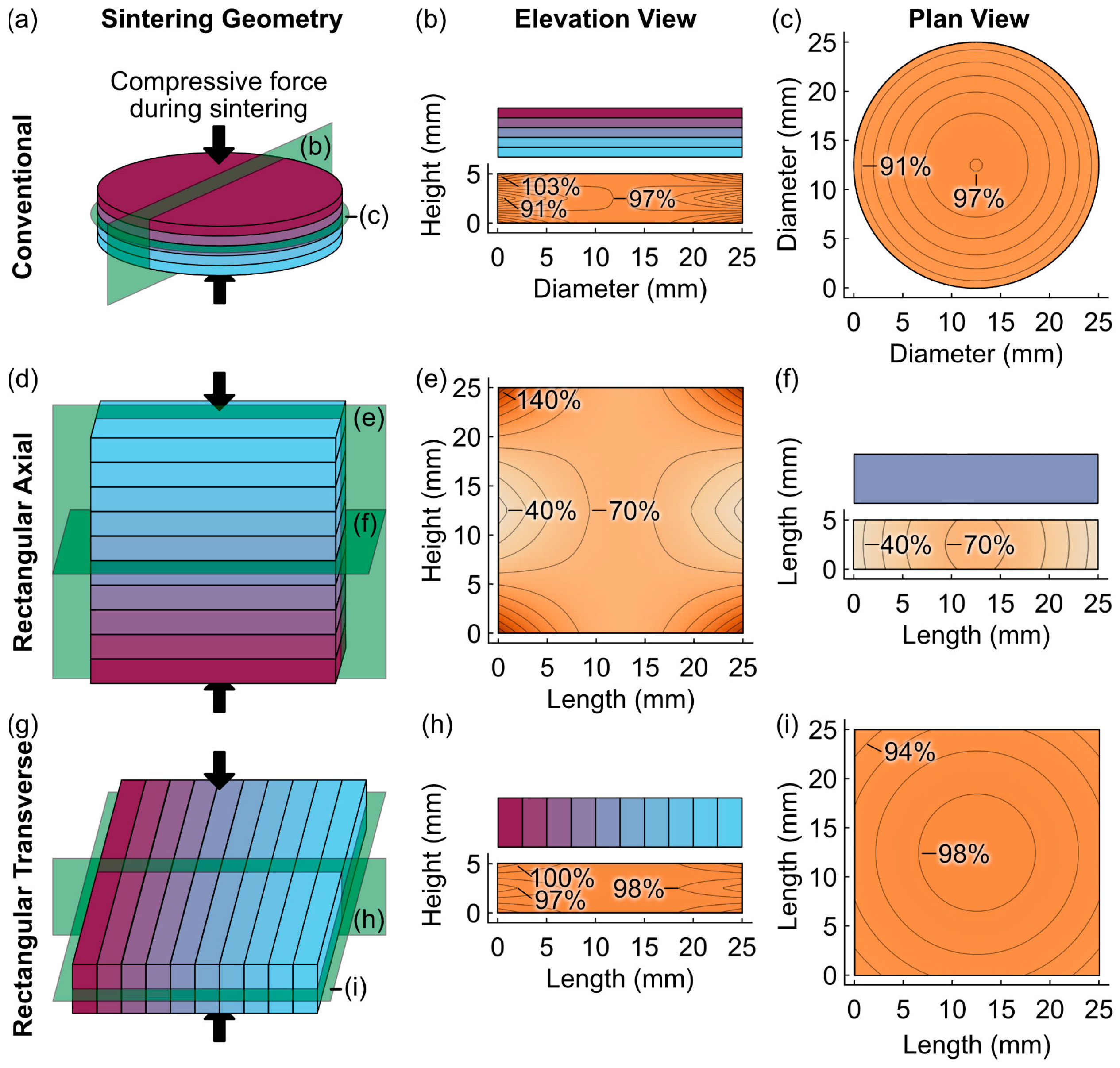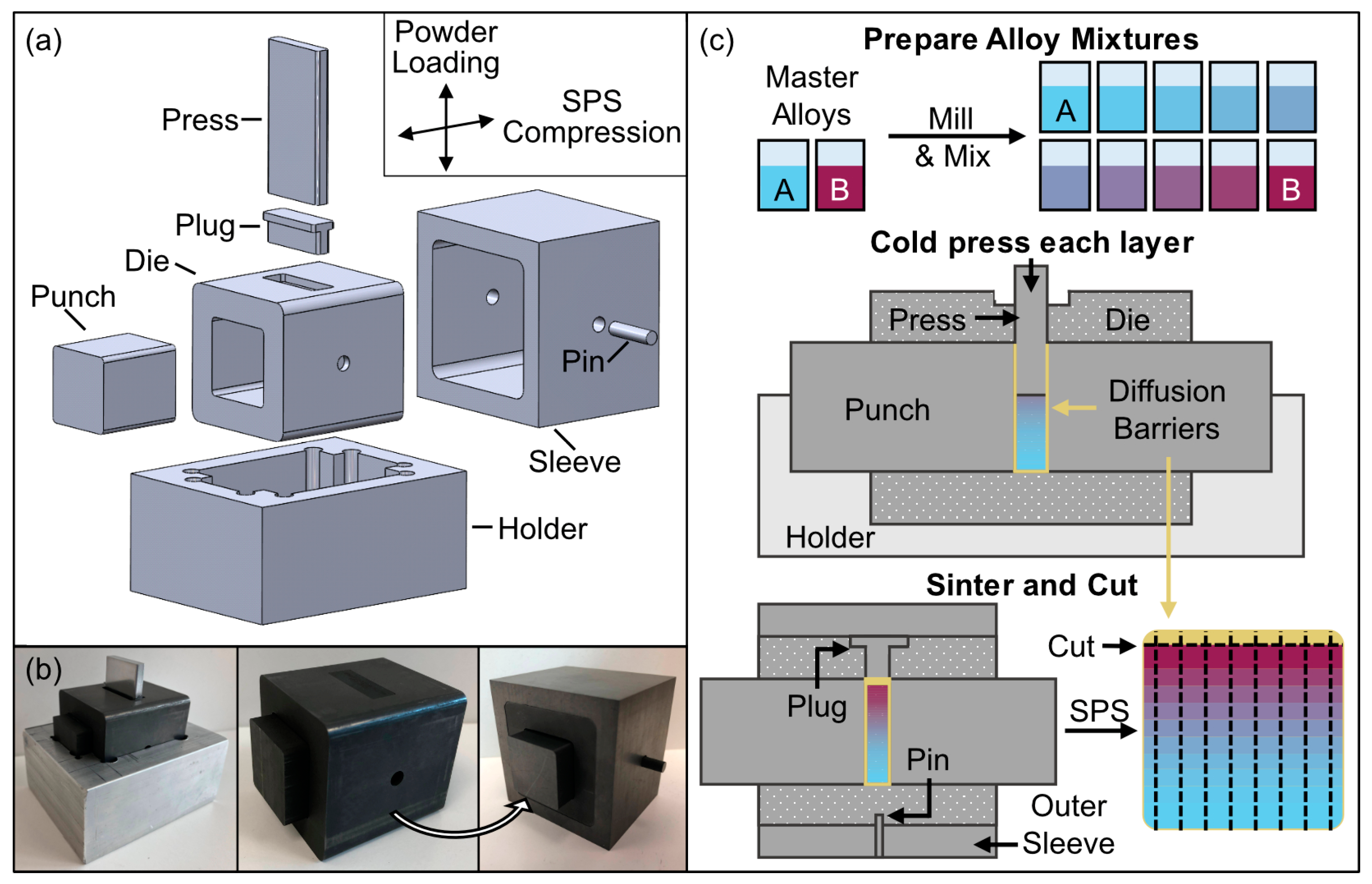High-Throughput Multi-Principal Element Alloy Exploration Using a Novel Composition Gradient Sintering Technique
Abstract
:1. Introduction
2. Design Approach
2.1. Geometry Pressure Distribution
2.2. Design Overview
3. Materials and Methods
3.1. Powder Preparation
3.2. Sintering and Annealing Process
3.3. Characterization
4. Results and Discussion
4.1. Starting Powders
4.2. Cu-Ni Gradient Samples
4.3. Mo-Nb Gradient Samples
4.4. MoNbTaWHfx Gradient Samples
4.5. Implications
5. Conclusions
- When considering various sample geometries for CAPAD, a high aspect ratio must be maintained to ensure proper pressure distribution through the powder pack. Thus, the rectangular tooling must be loaded from the side to form the composition gradient along the longest dimension.
- Upon densification via CAPAD, all alloy systems remained inhomogeneous due to the limited time at temperature, but the discrete loaded compositions could still be observed with EDS-area scans along the composition gradients.
- After subsequent annealing, the Ni-Cu gradient formed a uniform gradient, especially on the Cu-rich side with the lower melting point. Annealing improved the characterization of the Mo-Nb gradient, but it did not form a solid solution, and the MoNbTaWHfx gradient showed no change after annealing. For all systems, solutionizing came at the cost of pore growth.
Author Contributions
Funding
Data Availability Statement
Conflicts of Interest
References
- Wei, B.; Zhou, R.; Xu, D.; Chen, R.; Yu, X.; Cheng, P.; Cheng, J. Continuous WCu functional gradient material from pure W to WCu layer prepared by a modified sedimentation method. Nucl. Eng. Technol. 2022, 54, 4491–4498. [Google Scholar] [CrossRef]
- Pintsuk, G.; Brünings, S.E.; Döring, J.-E.; Linke, J.; Smid, I.; Xue, L. Development of W/Cu—Functionally graded materials. Fusion. Eng. Des. 2003, 66–68, 237–240. [Google Scholar] [CrossRef]
- Zhou, Z.-J.; Du, J.; Song, S.-X.; Zhong, Z.-H.; Ge, C.-C. Microstructural characterization of W/Cu functionally graded materials produced by a one-step resistance sintering method. J. Alloys Compd. 2007, 428, 146–150. [Google Scholar] [CrossRef]
- Tang, Y.; Qiu, W.; Chen, L.; Yang, X.; Song, Y.; Tang, J. Preparation of W–V functionally gradient material by spark plasma sintering. Nucl. Eng. Technol. 2020, 52, 1706–1713. [Google Scholar] [CrossRef]
- Ghorbanpour, S.; Sahu, S.; Deshmukh, K.; Borisov, E.; Riemslag, T.; Reinton, E.; Bertolo, V.; Jiang, Q.; Popovich, A.; Shamshurin, A.; et al. Effect of microstructure induced anisotropy on fatigue behaviour of functionally graded Inconel 718 fabricated by additive manufacturing. Mater. Charact. 2021, 179, 111350. [Google Scholar] [CrossRef]
- Naebe, M.; Shirvanimoghaddam, K. Functionally graded materials: A review of fabrication and properties. Appl. Mater. Today 2016, 5, 223–245. [Google Scholar] [CrossRef]
- Choi, K.H.; Kim, H.-S.; Park, C.H.; Kim, G.-H.; Baik, K.H.; Lee, S.H.; Kim, T.; Kim, H.S. High-temperature thermo-mechanical behavior of functionally graded materials produced by plasma sprayed coating: Experimental and modeling results. Met. Mater. Int. 2016, 22, 817–824. [Google Scholar] [CrossRef]
- Goudarzi, Z.M.; Valefi, Z.; Zamani, P. Effect of functionally graded structure design on durability and thermal insulation capacity of plasma-sprayed thick thermal barrier coating. Ceram. Int. 2021, 47, 34361–34379. [Google Scholar] [CrossRef]
- Naik, A.K.; Nazeer, M.; Prasad, D.K.V.D.; Laha, T.; Roy, S. Development of functionally graded ZrB2–B4C composites for lightweight ultrahigh-temperature aerospace applications. Ceram. Int. 2022, 48, 33332–33339. [Google Scholar] [CrossRef]
- Bahraminasab, M.; Ghaffari, S.; Eslami-Shahed, H. Al2O3-Ti functionally graded material prepared by spark plasma sintering for orthopaedic applications. J. Mech. Behav. Biomed. Mater. 2017, 72, 82–89. [Google Scholar] [CrossRef]
- Fujii, T.; Tohgo, K.; Iwao, M.; Shimamura, Y. Fracture toughness distribution of alumina-titanium functionally graded materials fabricated by spark plasma sintering. J. Alloys Compd. 2018, 766, 1–11. [Google Scholar] [CrossRef]
- Stewart, C.A.; Suzuki, A.; Pollock, T.M.; Levi, C.G. Rapid Assessment of Oxidation Behavior in Co-Based γ/γ′ Alloys. Oxid. Met. 2018, 90, 485–498. [Google Scholar] [CrossRef]
- Wang, F.; Mei, J.; Jiang, H.; Wu, X. Laser fabrication of Ti6Al4V/TiC composites using simultaneous powder and wire feed. Mater. Sci. Eng. A 2007, 445–446, 461–466. [Google Scholar] [CrossRef]
- Moghaddam, A.O.; Shaburova, N.A.; Samodurova, M.N.; Abdollahzadeh, A.; Trofimov, E.A. Additive manufacturing of high entropy alloys: A practical review. J. Mater. Sci. Technol. 2021, 77, 131–162. [Google Scholar] [CrossRef]
- Pegues, J.W.; Melia, M.A.; Puckett, R.; Whetten, S.R.; Argibay, N.; Kustas, A.B. Exploring additive manufacturing as a high-throughput screening tool for multiphase high entropy alloys. Addit. Manuf. 2021, 37, 101598. [Google Scholar] [CrossRef]
- Miracle, D.B.; Senkov, O.N. A critical review of high entropy alloys and related concepts. Acta Mater. 2017, 122, 448–511. [Google Scholar] [CrossRef]
- Diao, H.Y.; Feng, R.; Dahmen, K.A.; Liaw, P.K. Fundamental deformation behavior in high-entropy alloys: An overview. Curr. Opin. Solid. State Mater. Sci. 2017, 21, 252–266. [Google Scholar] [CrossRef]
- Yao, H.W.; Qiao, J.W.; Hawk, J.A.; Zhou, H.F.; Chen, M.W.; Gao, M.C. Mechanical properties of refractory high-entropy alloys: Experiments and modeling. J. Alloys Compd. 2017, 696, 1139–1150. [Google Scholar] [CrossRef]
- Birbilis, N.; Choudhary, S.; Scully, J.R.; Taheri, M.L. A perspective on corrosion of multi-principal element alloys. Npj Mater. Degrad. 2021, 5, 11. [Google Scholar] [CrossRef]
- Wang, Z.; Yan, Y.; Wu, Y.; Zhang, Y.; Zhao, X.; Su, Y.; Qiao, L. Recent research progress on the passivation and selective oxidation for the 3d-transition-metal and refractory multi-principal element alloys. Npj Mater. Degrad. 2023, 7, 86. [Google Scholar] [CrossRef]
- Nagy, P.; Rohbeck, N.; Widmer, R.N.; Hegedűs, Z.; Michler, J.; Pethö, L.; Lábár, J.L.; Gubicza, J. Combinatorial Study of Phase Composition, Microstructure and Mechanical Behavior of Co-Cr-Fe-Ni Nanocrystalline Film Processed by Multiple-Beam-Sputtering Physical Vapor Deposition. Materials 2022, 15, 2319. [Google Scholar] [CrossRef] [PubMed]
- Li, R.; Huang, T.; Zhang, J.; Jiang, C.; Zhang, Y.; Liaw, P.K. Microstructures, Mechanical Behavior, and Radiation Damage of (TiVCr)x-(TaW)1-x Binary System High-Entropy Alloy Films. Metals 2022, 12, 772. [Google Scholar] [CrossRef]
- Malik, P.; Kadoli, R. Nonlinear bending and free vibration response of SUS316-Al2O3 functionally graded plasma sprayed beams: Theoretical and experimental study. J. Vib. Control 2018, 24, 1171–1184. [Google Scholar] [CrossRef]
- Dobbelstein, H.; Gurevich, E.L.; George, E.P.; Ostendorf, A.; Laplanche, G. Laser metal deposition of compositionally graded TiZrNbTa refractory high-entropy alloys using elemental powder blends. Addit. Manuf. 2019, 25, 252–262. [Google Scholar] [CrossRef]
- Gwalani, B.; Gangireddy, S.; Shukla, S.; Yannetta, C.J.; Valentin, S.G.; Mishra, R.S.; Banerjee, R. Compositionally graded high entropy alloy with a strong front and ductile back. Mater. Today Commun. 2019, 20, 100602. [Google Scholar] [CrossRef]
- Borkar, T.; Chaudhary, V.; Gwalani, B.; Choudhuri, D.; Mikler, C.V.; Soni, V.; Alam, T.; Ramanujan, R.V.; Banerjee, R. A Combinatorial Approach for Assessing the Magnetic Properties of High Entropy Alloys: Role of Cr in AlCoxCr1–xFeNi. Adv. Eng. Mater. 2017, 19, 1700048. [Google Scholar] [CrossRef]
- Chaudhary, V.; Borkar, T.; Mikler, C.V.; Gwalani, B.; Choudhuri, D.; Soni, V.; Alam, T.; Ramanujan, R.V.; Banerjee, R. Additively Manufactured Functionally Graded FeNi based High Entropy Magnetic Alloys. In Proceedings of the 2018 IEEE International Magnetics Conference (INTERMAG), Singapore, 23–27 April 2018; p. 1. [Google Scholar] [CrossRef]
- Melia, M.A.; Whetten, S.R.; Puckett, R.; Jones, M.; Heiden, M.J.; Argibay, N.; Kustas, A.B. High-throughput additive manufacturing and characterization of refractory high entropy alloys. Appl. Mater. Today 2020, 19, 100560. [Google Scholar] [CrossRef]
- Moorehead, M.; Bertsch, K.; Niezgoda, M.; Parkin, C.; Elbakhshwan, M.; Sridharan, K.; Zhang, C.; Thoma, D.; Couet, A. High-throughput synthesis of Mo-Nb-Ta-W high-entropy alloys via additive manufacturing. Mater. Des. 2020, 187, 108358. [Google Scholar] [CrossRef]
- Garay, J.E. Current-Activated, Pressure-Assisted Densification of Materials. Annu. Rev. Mater. Res. 2010, 40, 445–468. [Google Scholar] [CrossRef]
- Feng, H.; Meng, Q.; Zhou, Y.; Jia, D. Spark plasma sintering of functionally graded material in the Ti–TiB2–B system. Mater. Sci. Eng. A 2005, 397, 92–97. [Google Scholar] [CrossRef]
- Thompson, A.R. Mechanics of powder pressing. I: Model for powder densification. Am. Ceram. Soc. Bull. 1981, 60, 237–243. [Google Scholar]
- Neumann, G.; Tuijn, C. Self-Diffusion and Impurity Diffusion in Pure Metals: Handbook of Experimental Data; Elsevier: Amsterdam, The Netherlands, 2011. [Google Scholar]







Disclaimer/Publisher’s Note: The statements, opinions and data contained in all publications are solely those of the individual author(s) and contributor(s) and not of MDPI and/or the editor(s). MDPI and/or the editor(s) disclaim responsibility for any injury to people or property resulting from any ideas, methods, instructions or products referred to in the content. |
© 2024 by the authors. Licensee MDPI, Basel, Switzerland. This article is an open access article distributed under the terms and conditions of the Creative Commons Attribution (CC BY) license (https://creativecommons.org/licenses/by/4.0/).
Share and Cite
Bresnahan, B.L.; Poerschke, D.L. High-Throughput Multi-Principal Element Alloy Exploration Using a Novel Composition Gradient Sintering Technique. Metals 2024, 14, 558. https://doi.org/10.3390/met14050558
Bresnahan BL, Poerschke DL. High-Throughput Multi-Principal Element Alloy Exploration Using a Novel Composition Gradient Sintering Technique. Metals. 2024; 14(5):558. https://doi.org/10.3390/met14050558
Chicago/Turabian StyleBresnahan, Brady L., and David L. Poerschke. 2024. "High-Throughput Multi-Principal Element Alloy Exploration Using a Novel Composition Gradient Sintering Technique" Metals 14, no. 5: 558. https://doi.org/10.3390/met14050558





